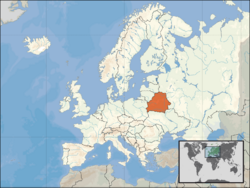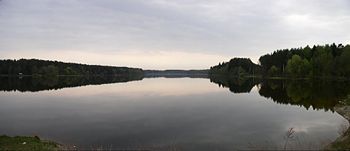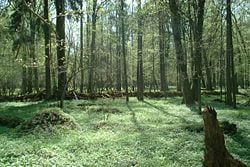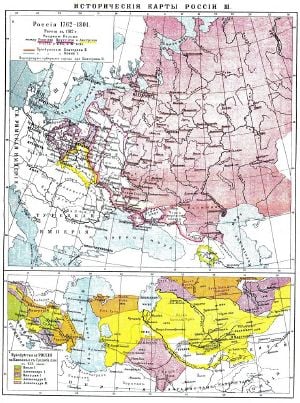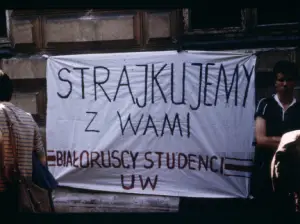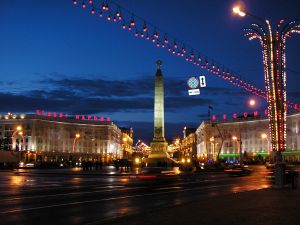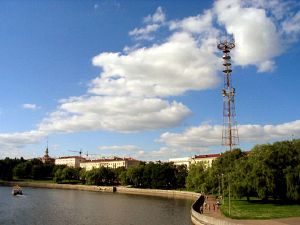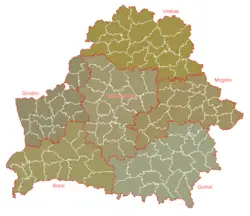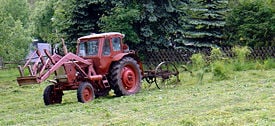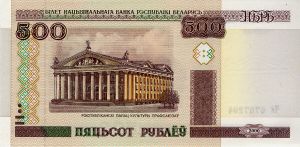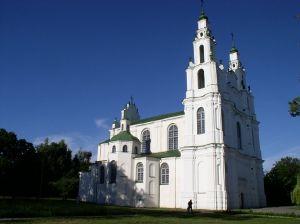Belarus
| –†—ć—Ā–Ņ—É–Ī–Ľ—Ė–ļ–į –Ď–Ķ–Ľ–į—Ä—É—Ā—Ć –†–Ķ—Ā–Ņ—É–Ī–Ľ–ł–ļ–į –Ď–Ķ–Ľ–į—Ä—É—Ā—Ć Republic of Belarus |
||||||
|---|---|---|---|---|---|---|
|
||||||
| Anthem:¬†–ú—č, –Ī–Ķ–Ľ–į—Ä—É—Ā—謆(Belarusian) My, Belarusy¬†(transliteration) We Belarusians |
||||||
| Capital (and largest city) | Minsk 53¬į55‚Ä≤N 27¬į33‚Ä≤E | |||||
| Official languages | Belarusian Russian |
|||||
| Ethnic groups (2009) | 83.7% Belarusians, 8.3% Russians, 3.1% Poles, 1.7% Ukrainians, 4.2% others and unspecified |
|||||
| Demonym | Belarusian | |||||
| Government | Presidential republic | |||||
|  -  | President | Alexander Lukashenko | ||||
|  -  | Prime Minister | Mikhail Myasnikovich | ||||
| Independence | from the Soviet Union  | |||||
|  -  | Declared | 27 July 1990  | ||||
|  -  | Established | 25 August 1991  | ||||
|  -  | Completed | 25 December 1991  | ||||
| Area | ||||||
|  -  | Total | 207,595 km² (85th) 80,155 sq mi  |
||||
|  -  | Water (%) | negligible (2.830 km2)1 | ||||
| Population | ||||||
|  -  | 2009 census | 9,503,807 (86th) | ||||
|  -  | Density | 45.8/km² (142nd) 120.8/sq mi |
||||
| GDP (PPP) | 2010 estimate | |||||
|  -  | Total | $131.201 billion[1]  | ||||
|  -  | Per capita | $13,909[1]  | ||||
| GDP (nominal) | 2010 estimate | |||||
|  -  | Total | $54.713 billion[1]  | ||||
|  -  | Per capita | $5,800[1]  | ||||
| Gini (2005) | 27.9[2] (low)  | |||||
| Currency | Belarusian ruble (BYR) |
|||||
| Time zone | EET (UTC+2) | |||||
|  -  | Summer (DST) | EEST (UTC+3) | ||||
| Internet TLD | .by | |||||
| Calling code | [[+375]] | |||||
| 1 | FAO's Information System on Water and Agriculture. FAO. Retrieved 4 April 2008. | |||||
Belarus (Belarusian and Russian: –Ď–Ķ–Ľ–į—Ä—É—Ā—Ć, transliteration: Byelarus‚Äô, Polish: BiaŇāoruŇõ) is a landlocked country in Eastern Europe that borders Russia to the north and east, Ukraine to the south, Poland to the west, and Lithuania and Latvia to the north. Its capital is Minsk; other major cities include Brest, Grodno, Gomel, Mogilev and Vitebsk. A third of the country is forested, and its strongest economic sectors are agriculture and manufacturing.
The history of Belarus is a story of domination by foreign powers, forced division and re-unification of the land, devastation during war and authoritarian rule following its 1991 independence.
The final unification of Belarusian lands within its modern borders took place in 1939, when the ethnically Belarusian lands that were part of interwar Poland were annexed by the USSR and attached to the Soviet Belarus. The territory and its nation were devastated in World War II, during which Belarus lost about a third of its population and more than half of its economic resources. After seven decades as a constituent republic of the USSR, Belarus declared its sovereignty on July 27, 1990, and independence from the Soviet Union on August 25, 1991. It has retained closer political and economic ties to Russia than any of the other former Soviet republics.
Its president since 1994, Alexander Lukashenko, has retained Soviet-era policies, such as state ownership of the economy, despite objections from Western governments. Government restrictions on freedom of speech, press and religion, as well as of peaceful assembly, continue into the twenty-first century. Because of its failure to protect labor rights, Belarus lost its European Union Generalized System of Preferences status in June 2007. It has been cited as a country of concern by both Amnesty International and Human Rights Watch.
Etymology
The name Belarus derives from the term White Russia, which first appeared in German and Latin medieval literature. The Latin term for the area was Russia Alba. Historically, the country was referred to in English as White Russia. Some sources translate the term as White Ruthenia, which can be used to describe either the area of Eastern Europe populated by Slavic people or the states that occupied the area. The first known use of White Russia to refer to Belarus was in the late-sixteenth century by Englishman Sir Jerome Horsey. During the seventeenth century, Russian tsars used White Rus', asserting that they were trying to recapture their heritage from the Polish-Lithuanian Commonwealth.
Belarus was named Belorussia (Russian: –Ď–Ķ–Ľ–ĺ—Ä—É—Ā—Ā–ł—Ź) in the days of Imperial Russia, and the Russian tsar was usually styled Tsar of All the Russias‚ÄĒGreat, Little, and White. Belorussia was the only Russian language name of the country until 1991, when the Supreme Soviet of the Belorussian Soviet Socialist Republic decreed by law that the new independent republic should be called Belarus (–Ď–Ķ–Ľ–į—Ä—É—Ā—Ć) in Russian and in all other language transcriptions of that name. The change was made to reflect adequately the Belarusian language form of the name.[3] Accordingly, the name Belorussia was replaced by Belarus in English, and, to some extent, in Russian, although the traditional name still persists in that language as well.
Geography
The country of Belarus covers 80,100 square miles (207,600 sq km), slightly smaller than the U.S. state of Kansas. It is landlocked, relatively flat, and contains large tracts of marshy land. According to a 1994 estimate by the United Nations Food and Agricultural Organization, 34 percent of Belarus was at that time covered by forests. Many streams and 11,000 lakes are found in Belarus. Three major rivers run through the country: the Neman, the Pripyat, and the Dnepr. The Neman flows westward toward the Baltic Sea and the Pripyat flows eastward to the Dnepr; the Dnepr flows southward towards the Black Sea. Belarus's highest point is Dzyarzhynskaya Hara (Dzyarzhynsk Hill) at 1132 feet (345 meters), and its lowest point is on the Neman River at 295 feet (90 meters).
The climate ranges from harsh winters, with average January temperatures at ‚ąí6¬†¬įC (21.2¬†¬įF), to cool and moist summers with an average temperature of 18¬†¬įC (64¬†¬įF). Belarus has an average annual rainfall of 21.7 to 27.5 inches (550 to 700 mm). The country experiences a yearly transition from a continental climate to a maritime climate.
Belarus's natural resources include peat deposits, small quantities of oil and natural gas, granite, dolomite (limestone), marl, chalk, sand, gravel, and clay.
Approximately 70 percent of the radiation from neighboring Ukraine's 1986 Chernobyl nuclear disaster entered Belarusian territory, and as of 2005 about a fifth of Belarusian land (principally farmland and forests in the southeastern provinces) continued to be affected by radiation fallout.[4] The United Nations and other agencies have aimed to reduce the level of radiation in affected areas, especially through the use of caesium binders and rapeseed cultivation, which are meant to decrease soil levels of caesium-137. [5][6]
Belarus is bordered by Latvia on the north, Lithuania to the northwest, Poland to the west, Russia to the north and east and Ukraine to the south. Treaties in 1995 and 1996 demarcated Belarus's borders with Latvia and Lithuania, but Belarus failed to ratify a 1997 treaty establishing the Belarus-Ukraine border. Belarus and Lithuania ratified final border demarcation documents in February 2007.[7]
Belarus has four World Heritage Sites: the Mir Castle Complex, the Niasvizh Castle, the BiaŇāowieŇľa Forest (shared with Poland), and the Struve Geodetic Arc (shared with nine other countries).[8] While three of these are cultural sites, the BiaŇāowieŇľa Forest is an ancient woodland straddling the border between Belarus and Poland. It is the only remaining part of the immense forest which once spread across the European Plain.
History
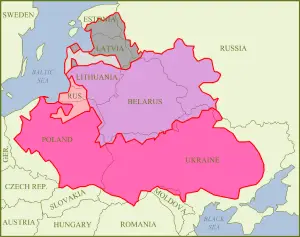
While archaeological evidence points to settlement in today's Belarus at least ten thousand years ago, recorded history begins with settlement by Baltic and Slavic tribes in the sixth century. They gradually came into contact with the Varangians, a band of warriors consisting of Scandinavians and Slavs from the Baltics. Though defeated and briefly exiled by the local population, the Varangians were later asked to return and helped to form a polity‚ÄĒcommonly referred to as the Kievan Rus'‚ÄĒin exchange for tribute. The Kievan Rus' state began in about 862 at the present-day city of Novgorod.[9]
Upon the death of Kievan Rus' ruler, Prince Yaroslav the Wise, (r. 1019 to 1054) the state split into independent principalities. These Ruthenian principalities were badly affected by a Mongol invasion in the thirteenth century, and many were later incorporated into the Grand Duchy of Lithuania. Of the principalities held by the Duchy, nine were settled by ancestors of the Belarusian people. During this time, the Duchy was involved in several military campaigns, including fighting on the side of Poland against the Teutonic Knights at the Battle of Grunwald in 1410; the joint victory allowed the Duchy to control the northwestern border lands of Eastern Europe.
On February 2, 1386, the Grand Duchy of Lithuania and the Kingdom of Poland were joined in a personal union through a marriage of their rulers. This union set in motion the developments that eventually resulted in the formation of the Polish-Lithuanian Commonwealth, created in 1569. The Russians, led by Tsar Ivan the III, began military conquests in 1486 in an attempt to gain the Kievan Rus' lands, specifically Belarus and Ukraine. The union between Poland and Lithuania ended in 1795, and the commonwealth was partitioned by Imperial Russia, Prussia, and Austria, dividing Belarus. Belarusian territories were acquired by the Russian Empire during the reign of Catherine II and held until their occupation by Germany during World War I.
During the negotiations of the Treaty of Brest-Litovsk, Belarus first declared independence on March 25, 1918, forming the Belarusian People's Republic. The Germans supported the BPR, which lasted for about ten months. Soon after the Germans were defeated, the BPR fell under the influence of the Bolsheviks and the Red Army and became the Byelorussian Soviet Socialist Republic in 1919. After Russian occupation of eastern and northern Lithuania, it was merged into the Lithuanian-Byelorussian Soviet Socialist Republic. Byelorussian lands were then split between Poland and the Soviets after the Polish-Soviet War ended in 1921, and the recreated Byelorussian SSR became a founding member of the Union of Soviet Socialist Republics in 1922.
In September 1939, as a result of the Molotov-Ribbentrop Pact, the Soviet Union invaded Poland and annexed its eastern lands, including most Polish-held Byelorussian land. Nazi Germany invaded the Soviet Union in 1941. Byelorussia was the hardest hit Soviet Republic in the war and remained in Nazi hands until 1944. During that time, Germany destroyed 209 out of 290 cities in the republic, 85 percent of the republic's industry, and more than one million buildings, while causing human losses estimated between two and three million (about a quarter to one-third of the total population). The Jewish population of Byelorussia was devastated during the Holocaust and never recovered.
The population of Belarus did not regain its pre-war level until 1971. After the war ended, Byelorussia was among the 51 founding countries of the United Nations Charter in 1945 and began rebuilding the Soviet Republic. During this time, the Byelorussian SSR became a major center of manufacturing in the western region of the USSR, increasing jobs and bringing an influx of ethnic Russians into the republic. The borders of Byelorussian SSR and Poland were redrawn to a point known as the Curzon Line.
Joseph Stalin implemented a policy of Sovietization to isolate the Byelorussian SSR from Western influences as well as to replace Belarus's cultural identity with that of Russia. This policy involved sending Russians from various parts of the Soviet Union and placing them in key positions in the Byelorussian SSR government. The official use of the Belarusian language and other cultural aspects were limited by Moscow. Following Stalin's death in 1953, successor Nikita Khrushchev continued this program, stating, "The sooner we all start speaking Russian, the faster we shall build communism."[10] When Soviet leader Mikhail Gorbachev began pushing through his reform plan, the Belarusian people delivered a petition to him in December 1986 explaining the loss of their culture.
In June 1988 at the rural site of Kurapaty near Minsk, archaeologist Zianon Pazniak, the leader of Christian Conservative Party of the BPF, discovered mass graves which contained about 250,000 bodies of victims executed in the period 1937-1941. Some nationalists contend that this discovery is proof that the Soviet government was trying to erase the Belarusian people, causing Belarusian nationalists to seek independence.
Two years later, in March 1990, elections for seats in the Supreme Soviet of the Byelorussian SSR took place. Though the pro-independence Belarusian Popular Front took only 10 percent of the seats, the populace was content with the selection of the delegates. Belarus declared itself sovereign on July 27, 1990, by issuing the Declaration of State Sovereignty of the Belarusian Soviet Socialist Republic. With the support of the Communist Party, the country's name was changed to the Republic of Belarus on August 25, 1991. Stanislav Shushkevich, the Chairman of the Supreme Soviet of Belarus, met with Boris Yeltsin of Russia and Leonid Kravchuk of Ukraine on December 8, 1991 in Belavezhskaya Pushcha to formally declare the dissolution of the Soviet Union and the formation of the Commonwealth of Independent States. A national constitution was adopted in March 1994, in which the functions of prime minister were given to the president.
Two-round elections for the presidency on June 24 and July 10, 1994 resulted in the politically unknown Alexander Lukashenko winning more than 45 percent of the vote in the first round and 80 percent in the second round, beating Vyacheslav Kebich who got 14 percent. Lukashenko was re-elected in 2001 and in 2006.
Government and politics
Belarus is a presidential republic, governed by a president and the National Assembly. In accordance with the constitution, the president is elected once in five years. The National Assembly is a bicameral parliament comprising the 110-member House of Representatives (the lower house) and the 64-member Council of the Republic (the upper house). The House of Representatives has the power to appoint the prime minister, make constitutional amendments, call for a vote of confidence on the prime minister, and make suggestions on foreign and domestic policy. The Council of the Republic has the power to select various government officials, conduct an impeachment trial of the president, and accept or reject the bills passed by the House of Representatives. Each chamber has the ability to veto any law passed by local officials if it is contrary to the Constitution of Belarus. The government includes a Council of Ministers, headed by the prime minister. The members of this council need not be members of the legislature and are appointed by the president. The judiciary comprises the Supreme Court and specialized courts such as the Constitutional Court, which deals with specific issues related to constitutional and business law. The judges of national courts are appointed by the president and confirmed by the Council of the Republic. For criminal cases, the highest court of appeal is the Supreme Court. The Belarusian Constitution forbids the use of special extra-judicial courts.
In 2007, 98 of the 110 members of the House of Representatives were not affiliated with any political party and of the remaining twelve members, eight belonged to the Communist Party of Belarus, three to the Agrarian Party of Belarus, and one to the Liberal Democratic Party of Belarus. Most of the non-partisans represent a wide scope of social organizations such as workers' collectives, public associations and civil society organizations.
Human rights and freedom
Groups such as the Organization for Security and Co-operation in Europe (OSCE) declared the 2004 presidential election "un-free" because of the opposition parties' poor results and media bias in favor of the government. In the country's 2006 presidential election, Lukashenko was opposed by Alaksandar Milinkievińć, a candidate representing a coalition of opposition parties, and by Alaksandar Kazulin of the Social Democrats. Kazulin was detained and beaten by police during protests surrounding the All Belarusian People's Assembly. Lukashenko won the election with 80 percent of the vote, but the OSCE and other organizations called the election unfair.
Alexander Lukashenko, who has been the president of Belarus since 1994, has described himself as having an "authoritarian ruling style."[11] Western countries have described Belarus under Lukashenko as a dictatorship, while the government has accused the same Western powers of trying to oust Lukashenko.[12]
The Council of Europe has barred Belarus from European Union membership since 1997 for undemocratic voting and election irregularities in the November 1996 constitutional referendum and parliament bi-elections.[13]
The Belarusian government is also criticized for human rights violations and its actions against non-governmental organizations, independent journalists, national minorities, and opposition politicians.[14] [15]
Belarus is the only nation in Europe that retains the death penalty for certain crimes during times of peace as well as times of war. In testimony to the U.S. Senate Committee on Foreign Relations, United States Secretary of State Condoleezza Rice labeled Belarus among the six nations of the "outposts of tyranny."[16]
All media companies are regulated by the Law On Press and Other Mass Media, passed on January 13, 1995. This grants freedom of press; however, Article 5 states that slander cannot be made against the president of Belarus or other officials outlined in the national constitution. The Belarusian Government has since been criticized for acting against media outlets. Newspapers such as Nasa Niva and the Belaruskaya Delovaya Gazeta were targeted for closure by the authorities after they published reports critical of President Lukashenko or other government officials.[17] The Organization for Security and Co-operation in Europe and Freedom House have commented regarding the loss of press freedom in Belarus. In 2005, Freedom House gave Belarus a score of 6.75 (not free) when it came to dealing with press freedom. Another issue for the Belarusian press is the unresolved disappearance of several journalists.[18]
Foreign relations and military
Belarus and Russia have been close trading partners and diplomatic allies since the breakup of the Soviet Union. Belarus is dependent on Russia for imports of raw materials and for its export market. The Union of Russia and Belarus, a supranational confederation, was established in a 1996‚Äď1999 series of treaties that called for monetary union, equal rights, single citizenship, and a common foreign and defense policy. Although the future of the Union was in doubt because of Belarus' repeated delays of monetary union, the lack of a referendum date for the draft constitution, and a 2006‚Äď2007 dispute about petroleum trade, on December 11, 2007, reports emerged that a framework for the new state had been discussed between both countries.[19] On May 27, 2008, Belarusian President Lukashenko said that he had named Russian Prime Minister Vladimir Putin the "prime minister" of the Russia-Belarus alliance. The meaning of the move was not immediately clear; however, there is speculation that Putin may become president of a unified state of Russia and Belarus after having stepped down as Russian president in May 2008.[20]
Belarus was a founding member of the Commonwealth of Independent States (CIS). The country has trade agreements with several European Union member states (despite other member states' travel ban on Lukashenko and top officials), as well as with its neighbors Lithuania, Poland and Latvia.
Bilateral relations with the United States are strained because of the U.S. Department of State's support for various pro-democracy NGOs and because the Belarusian government has made it harder for US-based organizations to operate within the country. The 2004 US Belarus Democracy Act continued this trend, authorizing funding for pro-democracy Belarusian NGOs and forbidding loans to the Belarusian government except for humanitarian purposes.[21] Despite this, the two nations cooperate on intellectual property protection, prevention of human trafficking and technology crime, and disaster relief.
Belarus has increased cooperation with China, strengthened by the visit of President Lukashenko to that country in October 2005. Belarus has strong ties with Syria, which President Lukashenko considers a key partner in the Middle East. In addition to the CIS, Belarus has membership in the Eurasian Economic Community and the Collective Security Treaty Organization. Belarus has been a member of the international Non-Aligned Movement since 1998 and a member of the United Nations since its founding in 1945.
Military
Belarus' Armed Forces, which were formed in 1992 using parts of the former Soviet Armed Forces, consists of three branches: the Army, the Air Force, and the Ministry of Defense joint staff. The transformation of the ex-Soviet forces into the Armed Forces of Belarus, which was completed in 1997, reduced the number of its soldiers by 30,000 and restructured its leadership and military formations.
Most of Belarus's service members are conscripts, who serve for 12 months if they have higher education or 18 months if they do not. However, demographic decreases in the Belarusians of conscription age have increased the importance of contract soldiers, who numbered 12,000 in 2001.
In 2005, approximately 1.4 percent of Belarus's gross domestic product was devoted to military expenditures.[22] Belarus has not expressed a desire to join NATO but has participated in the Individual Partnership Program since 1997.
Provinces and districts
Belarus is divided into six voblasts, or administrative division (provinces), which are named after the cities that serve as their administrative centers. Each voblast has a provincial legislative authority, called an oblsovet. which is elected by the voblast's residents, and a provincial executive authority called a voblast administration, whose leader is appointed by the president. Voblasts are further subdivided into raions (commonly translated as districts or regions). As with voblasts, each raion has its own legislative authority (raisovet, or raion council) elected by its residents, and an executive authority (raion administration) appointed by higher executive powers. As of 2002, there are six voblasts, 118 raions, 102 towns and 108 urbanized settlements. Minsk is given a special status, due to the city serving as the national capital. Minsk City is run by an executive committee and granted a charter of self-rule by the national government.
Voblasts (with administrative centers):
- Brest Voblast (Brest)
- Homel Voblast (Homel)
- Hrodna Voblast (Hrodna)
- Mahilyow Voblast (Mahilyow)
- Minsk Voblast (Minsk)
- Vitsebsk Voblast (Vitsebsk)
Special administrative district:
- Minsk City
Economy
Following the collapse of the Soviet Union all former Soviet republics faced a deep economic crisis. Belarus' path of overcoming this crisis was "market socialism," launched by Alexander Lukashenko following his 1994 election to the presidency. In keeping with this policy, administrative controls over prices and currency exchange rates were introduced. Also the state's right to intervene in the management of private enterprise was expanded, but on March 4, 2008, the President issued a decree abolishing the golden share rule in a clear movement to improve its international rating regarding foreign investment.
As part of the former Soviet Union, Belarus had a relatively well-developed industrial base which it retained even after the break-up of the U.S.S.R. The country also has a broad agricultural base and a high education level. Among the former republics of the Soviet Union, it had one of the highest standards of living. However, the country had to face the difficult challenge of moving from a state-run economy with high priority on military production and heavy industry to a civilian, free-market system.
After an initial outburst of capitalist reform from 1991-1994, including privatization of state enterprises, creation of institutions of private property, and entrepreneurship, Belarus under Lukashenko has greatly slowed its pace of privatization and other market reforms, emphasizing the need for a "socially oriented market economy." About 80 percent of all industry remains in state hands, and foreign investment has been hindered by a climate hostile to business. Banks, which had been privatized after independence, were re-nationalized under Lukashenko.
Economic output, which declined for several years, revived somewhat in the late 1990s, but the economy remains dependent on Russian subsidies. Until 2000, subsidies to state enterprises and price controls on industrial and consumer staples constituted a major feature of the Belarusian economy. Inflationary monetary practices, including the printing of money also has been regularly used to finance real sector growth and to cover the payment of salaries and pensions.
In addition to the burdens imposed by high inflation, businesses have been subject to pressure on the part of central and local governments including arbitrary changes in regulations, numerous rigorous inspections, and retroactive application of new business regulations which prohibit formerly legal practices.
As the Belarusian economy is closely tied to Russia's economy, the latter's financial crisis of 1998 hit Belarus nearly equally as hard. In the 1990s poverty became a significant problem. Research carried out in Belarus in 1996 under the support of the World Bank showed that the number of poor had sharply increased; from 5 percent in 1992 to 22 percent by 1995. According to official statistics, 26.7 percent of urban population and 33.6 percent of rural population were below the poverty line in 2001.[23][24][25]
However, efforts by the Belarusian government and some favorable factors such as the union with Russia which opened vast markets for Belarusian goods and also allowed Belarus to buy oil and gas at Russia's internal price, allowed Belarus to bypass the severe economic hardships and crises that many former Soviet Union transition economies encountered. It resulted in the economic growth seen in recent years. According to the United Nations' World Economic Situation and Prospects 2006 report Belarus registers major economic growth: GDP growth rate as low as 3 percent in 1999 showed 11 percent (2nd place in CIS) in 2004 and 8.5 percent (4th place after Azerbaijan and Kazakhstan - oil and gas exporters - and Armenia) in 2005. In terms of GDP growth rate Belarus also outperforms neighboring Poland, Latvia and Lithuania.
Peat, the country's most valuable resource, is used for fuel and fertilizer and in the chemical industry. Belarus also has deposits of clay, sand, chalk, dolomite, phosphorite, and rock and potassium salt. Forests cover approximately a third of the land, and lumbering is an important occupation. Potatoes, flax, hemp, sugarbeets, rye, oats, and wheat are the chief agricultural products. Dairy and beef cattle, pigs, and chickens are raised. Belarus has only small reserves of petroleum and natural gas and imports most of its oil and gas from Russia. The main branches of industry produce tractors and trucks, earth movers for use in construction and mining, metal-cutting machine tools, agricultural equipment, motorcycles, chemicals, fertilizer, textiles, and consumer goods. The chief trading partners are Russia, Ukraine, Poland, and Germany.
Because of its failure to protect labor rights, Belarus lost its E.U. Generalized System of Preferences status on June 21, 2007, which raised tariff rates to their prior most-favored nation levels.[26] Belarus applied to become a member of the World Trade Organization in 1993.
The massive nuclear accident of April 26, 1986 at the Chernobyl nuclear power plant across the border in Ukraine, had a devastating effect on Belarus; as a result of the radiation release, agriculture in a large part of the country was destroyed, and many villages were abandoned. Resettlement and medical costs were substantial and long-term.
Demographics
Ethnic Belarusians constitute 81.2 percent of Belarus's total population. The next largest ethnic groups are Russians (11.4 percent), Poles (3.9 percent), and Ukrainians (2.4 percent). Belarus's two official languages are Belarusian and Russian, spoken at home by 36.7 percent and 62.8 percent of Belarusians, respectively. Minorities also speak Polish, Ukrainian and Eastern Yiddish.
Belarus has a population density of about 50 people per square kilometer (127 per sq mi); 71.7 percent of its total population is concentrated in urban areas. Minsk, the nation's capital and largest city, is home to 1,741,400 of Belarus's 9,724,700 residents. Gomel, with 481,000 people, is the second largest city and serves as the capital of the Homel Oblast. Other large cities are Mogilev (365,100), Vitebsk (342,400), Hrodna (314,800) and Brest (298,300).
Like many other European countries, Belarus has a negative population growth rate and a negative natural growth rate. In 2007, Belarus' population declined by 0.41 percent and its fertility rate was 1.22, well below the replacement rate. Its net migration rate is +0.38 per 1,000, indicating that Belarus experiences slightly more immigration than emigration. As of 2007, 69.7 percent of Belarus's population was aged 14 to 64; 16 percent was under 14, and 14.6 percent was 65 or older. Its population is also aging: while the current median age is 37, it is estimated that Belarusians' median age will be 51 in 2050. There are about 0.88 males per female in Belarus. The average life expectancy is 68.7 years (63.0 years for males and 74.9 years for females). Over 99 percent of Belarusians are literate.
Belarus has historically been a Russian Orthodox country, with minorities practicing Catholicism, Judaism, and other religions. Most Belarusians converted to the Russian Orthodox Church following Belarus' annexation by Russia after the partitions of the Polish-Lithuanian Commonwealth. Belarus's Roman Catholic minority, which makes up perhaps 10 percent of the country's population and is concentrated in the western part of the country, especially around Hrodna, is made up of a mixture of Belarusians and the country's Polish and Lithuanian minorities. About 1 percent belong to the Belarusian Greek Catholic Church. Belarus was once a major center of the European Jewish population, with 10 percent of its population being Jewish, but the population of Jews has been reduced by war, starvation, and the Holocaust to a tiny minority of about 1 percent or less. Emigration from Belarus has been an additional cause for the shrinking number of Jewish residents.
According to Article 16 of its Constitution, Belarus has no official religion. While the freedom of worship is granted in the same article, religious organizations that are deemed harmful to the government or social order of the country can be prohibited.
Culture
The Belarusian government sponsors annual cultural festivals including the Slavianski Bazaar in Vitebsk, which showcases Belarusian performers, artists, writers, musicians, and actors. Several state holidays, such as Independence Day and Victory Day, attract large crowds and often include displays such as fireworks and military parades, especially in Vitebsk and Minsk. The government's Ministry of Culture finances events promoting Belarusian arts and culture both inside and outside the country.
Much of Belarus' architectural heritage was destroyed during World War II, especially in Minsk. While the Minsk city center was rebuilt in the grandiose Stalinist style with its classical borrowings, older surviving parts of the country reflect period religious architecture. The Cathedral of Saint Sophia in Polatsk was built in the Eastern Orthodox style in the eleventh century. From the twelfth to sixteenth centuries buildings were constructed in stone fortress style. The Baroque style, linked to the eastward movement of the Roman Catholic Church, is evident in the Jesuit, Bernardine, and Bridgettine churches in Hrodna. Classical styles became popular in the eighteenth century, as seen in the Governor’s Palace in Hrodna.[27] Mir Castle, with its successive cultural influences (Gothic, Renaissance and Baroque) that blend to create an impressive monument recognized by UNESCO as a World Heritage Site. It is used for historical re-enactments to celebrate Medieval Belarus historical events and dancing.
Belarusian literature began with eleventh- to thirteenth-century religious writing; of which the work of twelfth-century poet Kiryla Turauski is representative. Rhyming was common in these works, which were generally written in Old Belarusian, Latin, Polish or Church-Slavic. By the sixteenth century, Polatsk resident Francysk Skaryna translated the Bible into Belarusian. It was published in Prague and Vilnius between 1517 and 1525, making it the first book printed in Belarus or anywhere in Eastern Europe. The modern period of Belarusian literature began in the late nineteenth century; one important writer was Yanka Kupala. Many of the writers at the time, such as UŇāadzimir ŇĹyŇāka, Kazimir Svayak, Yakub Kolas, ŇĻmitrok Biadula and Maksim Haretski, wrote for a Belarusian language paper called Nasha Niva, published in Vilnius.
Belarus experienced long periods of foreign control throughout its history during which periods considerable efforts were made to suppress both its language and culture. While under Soviet control free development of literature occurred only in Belarus' Polish-held territory. A number of poets and authors went into exile while the country was under Nazi occupation and returned only in the 1960s. The last major revival of the Belarusian literature occurred in the 1960s with novels published by Vasil BykaŇ≠ and UŇāadzimir Karatkievińć.
In the seventeenth century, Polish composer Stanislaw Moniuszko composed operas and chamber music pieces while living in Minsk. During his stay, he worked with Belarusian poet Vincent Dunin-Marcinkevich and created the opera Sielanka (Peasant Woman). At the end of the nineteenth century, major Belarusian cities formed their own opera and ballet companies. The ballet Nightingale by M. Kroshner was composed during the Soviet era and became the first Belarusian ballet showcased at the National Academic Bolshoi Ballet Theatre in Minsk. After the "Great Patriotic War" of 1941 to 1945, music focused on the hardships of the Belarusian people or on those who took up arms in defense of the homeland. During this period, A. Bogatyryov, creator of the opera In Polesye Virgin Forest, served as the "tutor" of Belarusian composers. The National Academic Theatre of Ballet, in Minsk, was awarded the Benois de la Dance Prize in 1996 as the top ballet company in the world. Although rock music has risen in popularity in recent years, the Belarusian government has suppressed the development of popular music through various legal and economic mechanisms.
The traditional two piece Belarusian dress originated from the Kievan Rus' period, and continues to be worn today at special functions. Because of the cool climate, the clothes were made of fabrics that provided closed covering and warmth, such as flax or wool. The Belarusian nobles usually had their fabrics imported and chose the colors of red, blue or green. The clothing is decorated with ornate patterns influenced by the neighboring cultures: Poles, Lithuanians, Latvians, Russians, and other European nations. Each region of Belarus has developed specific design patterns. An ornamental pattern used on some early dresses is currently used to decorate the hoist of the Belarusian national flag, adopted in a disputed referendum in 1995.
Notes
- ‚ÜĎ 1.0 1.1 1.2 1.3 Error on call to template:cite web: Parameters url and title must be specified. International Monetary Fund.
- ‚ÜĎ Error on call to template:cite web: Parameters url and title must be specified. The World Factbook. CIA.
- ‚ÜĎ Pravo - Law of the Republic of Belarus. Law of the Republic of Belarus (in Russian) Retrieved July 9, 2008.
- ‚ÜĎ Sarah Rainsford. April 26, 2005. Belarus cursed by Chernobyl BBC News. Retrieved July 9, 2008.
- ‚ÜĎ UN Office for the Coordination of Humanitarian Affairs. 2004. The United Nations and Chernobyl - The Republic of Belarus.
- ‚ÜĎ Marilyn Smith. Ecological reservation in Belarus fosters new approaches to soil remediation International Atomic Energy Agency. Retrieved July 9, 2008.
- ‚ÜĎ Lithuanian Ministry of Foreign Affairs. Lithuania's Cooperation with Belarus Retrieved July 9, 2008.
- ‚ÜĎ UNESCO World Heritage Centre. Belarus Retrieved July 10, 2008.
- ‚ÜĎ The foreign quarterly review. 1827. (London: Treuttel and W√ľrtz, Treuttel, Jun, and Richter).
- ‚ÜĎ Helen Fedor. 1995. Belarus - Stalin and Russification Library of Congress; Country Studies. Retrieved July 9, 2008.
- ‚ÜĎ BBC News. January 9, 2007. Profile: Alexander Lukashenko Retrieved July 9, 2008.
- ‚ÜĎ Stephen Mulvey. September 10, 2001. Profile: Europe's last dictator? BBC News. Retrieved July 9, 2008.
- ‚ÜĎ Press Service of the Council of Europe. January 17, 1997. Belarus suspended from the Council of Europe Retrieved March 3, 2006.
- ‚ÜĎ Human Rights Watch. 2005. Human Rights Overview - Belarus Retrieved July 9, 2008.
- ‚ÜĎ Amnesty International. Republic of Belarus Retrieved July 9, 2008.
- ‚ÜĎ Condoleezza Rice, January 18, 2005. Opening Statement by Dr. Condoleezza Rice, Senate Foreign Relations Committee U.S. Senate Committee on Foreign Relations. Retrieved July 9, 2008.
- ‚ÜĎ Philip T. Reeker, May 30, 2003. Media Freedom in Belarus. U.S. Department of State. Retrieved July 11, 2008.
- ‚ÜĎ Vitali Silitski, 2005. Country Report - Belarus. Freedom House. Retrieved July 11, 2008.
- ‚ÜĎ AP, Reuters. December 10, 2007. Russia-Belarus Union Presidency Dismissed The Moscow Times. Retrieved July 9, 2008.
- ‚ÜĎ Associated Press. May 27, 2008. Putin named PM of Belarus-Russia alliance MSNBC. Retrieved July 9, 2008.
- ‚ÜĎ Bureau of International Information Programs. October 21, 2004. Belarus Democracy Act Will Help Cause of Freedom, Bush Says United States State Department. Retrieved July 9, 2008.
- ‚ÜĎ CIA World Factbook. 2005. Belarus - Military Retrieved July 9, 2008.
- ‚ÜĎ Embassy of the Republic of Belarus in the United States. Summary of the Report ‚ÄúBelarus: Poverty Assessment. Can Poverty Reduction and Access to Services Be Sustained?‚ÄĚ Retrieved July 10, 2008.
- ‚ÜĎ United Nations Development Program. UNDP and the Government of Belarus have launched a new joint project aimed at elaborating the national poverty reduction strategy Retrieved July 10, 2008.
- ‚ÜĎ World Bank. Household Archives Poverty Assessment Summaries Retrieved July 10, 2008.
- ‚ÜĎ European Union. November 2006. The EU's Relationship With Belarus - Trade Retrieved July 10, 2008.
- ‚ÜĎ Encyclop√¶dia Britannica Online. 2008. Belarus Retrieved July 10, 2008.
ReferencesISBN links support NWE through referral fees
- Birgerson, Susanne Michele. After the breakup of a multi-ethnic empire: Russia, successor states, and Eurasian security. Westport, CT: Praeger, 2002. ISBN 0275969657
- CIA World Factbook. Belarus June 2008.Retrieved August 26, 2019.
- Eastern Europe, Russia and Central Asia 2003. Regional surveys of the world. London: Europa, 2002. ISBN 1857431375
- Fedor, Helen, ed. Belarus: A Country Study. Washington: GPO for the Library of Congress, 1995. Online: Belarus Library of Congress. Retrieved August 26, 2019.
- Jones, Michael. The New Cambridge Medieval History. Volume VI, c.1300-c.1415. Cambridge: Cambridge University Press, 2000. ISBN 0521362903
- Lerski, Jerzy J., Piotr Wróbel, and Richard J. Kozicki. Historical Dictionary of Poland, 966-1945. Westport, CT: Greenwood Press, 1996. ISBN 0313260079
- Nowak, Andrzej. The Russo-Polish Historical Confrontation Rice University - Sarmatian Review XVII. 1997. Retrieved August 26, 2019.
- Robinson, Charles H. The Conversion of Europe. London: Longmans, Green. online [1] googlebooks. 1917. Retrieved August 26, 2019.
- Scheuch, Erwin K., and David Sciulli. The annals of the International Institute of Sociology: Societies, corporations, and the nation state v. 7. Leiden: Brill, 2000. ISBN 9004116648
- U.S. Department of State. Background Note: Belarus Retrieved August 26, 2019.
- Zaprudnik, Jan. Belarus: at a Crossroads in History. Westview series on the post-Soviet republics. Boulder: Westview Press, 1993. ISBN 0813317940
External links
All links retrieved September 27, 2023.
- The Virtual Guide to Belarus
- Belarus CIA World Factbook
Albania · Andorra · Armenia2 · Austria · Azerbaijan1 · Belarus · Belgium · Bosnia and Herzegovina · Bulgaria · Croatia · Cyprus2 · Czech Republic · Denmark3 · Estonia · Finland · France3 · Georgia1 · Germany · Greece · Hungary · Iceland · Ireland · Italy · Kazakhstan1 · Latvia · Liechtenstein · Lithuania · Luxembourg · Republic of Macedonia · Malta · Moldova · Monaco · Montenegro · Netherlands3 · Norway3 · Poland · Portugal · Romania · Russia1 · San Marino · Serbia · Slovakia · Slovenia · Spain3 · Sweden · Switzerland · Turkey1 · Ukraine · United Kingdom3 · Vatican City
1 Has majority of its territory in Asia.  2 Entirely in Asia but having socio-political connections with Europe.  3 Has dependencies or similar territories outside Europe.
| |||||||
| |||||||
Credits
New World Encyclopedia writers and editors rewrote and completed the Wikipedia article in accordance with New World Encyclopedia standards. This article abides by terms of the Creative Commons CC-by-sa 3.0 License (CC-by-sa), which may be used and disseminated with proper attribution. Credit is due under the terms of this license that can reference both the New World Encyclopedia contributors and the selfless volunteer contributors of the Wikimedia Foundation. To cite this article click here for a list of acceptable citing formats.The history of earlier contributions by wikipedians is accessible to researchers here:
The history of this article since it was imported to New World Encyclopedia:
Note: Some restrictions may apply to use of individual images which are separately licensed.


